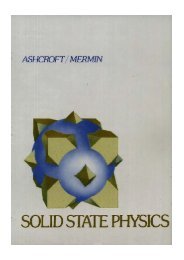[Masao_Doi]_Soft_Matter_Physics
Create successful ePaper yourself
Turn your PDF publications into a flip-book with our unique Google optimized e-Paper software.
What is soft matter?<br />
1<br />
<strong>Soft</strong> matter includes a large variety of materials, typically composed<br />
of polymers, colloids, liquid crystals, surfactants, and other mesoscopic<br />
constituents. In this chapter, we shall discuss (i) what are these materials,<br />
(ii) what are the common characteristics of these materials, and<br />
(iii) what is the physics that gives such characteristics to soft matter.<br />
1.1 Polymers<br />
Polymers are long string-like molecules made of certain chemical units<br />
called monomers. The monomers are connected sequentially as shown in<br />
Fig. 1.1. The number of monomers in a polymer is typically several thousand,<br />
and can be as large as tens of millions. Polymers are indispensable<br />
materials in modern technology; they are used as plastics, rubbers, films,<br />
and textiles.<br />
Polymers are also the basic molecules of life. The machinery of life is<br />
realized by proteins which are natural polymers made of amino acids.<br />
The genetic information of life is inscribed in another important class of<br />
bio-polymer, DNA.<br />
In polymers, a variety of materials can be produced simply by changing<br />
the types of monomers and the way they are connected. Polymers<br />
are usually string-like as shown in Fig. 1.2(a), but branches can be introduced<br />
as in Fig. 1.2(b) or the strings can be cross-linked as in Fig. 1.2(c).<br />
Plastics are usually made of string-like polymers (Fig. 1.2(a)). They can<br />
be brought into a liquid state which can be easily molded into any desired<br />
shapes. On the other hand, rubbers are made of cross-linked polymers<br />
(Fig. 1.2(c)). Since the molecules are all connected, rubbers cannot flow.<br />
They change their shape under external forces, but recover their original<br />
shape when the forces are removed. The branched polymers (Fig. 1.2(b))<br />
are intermediate, and behave like a rubbery material which can flow. The<br />
adhesives used in adhesive tapes are made of branched polymers which<br />
are intermediate between the liquid state and rubbery state.<br />
Depending on the chemical structure of monomers, polymeric materials<br />
can be very soft, like rubbers in rubber bands, or can be very<br />
hard, like plastics in car bumpers. Materials which are hard for small<br />
strain, but become plastic for large strain have been made by mixing<br />
these monomers. New types of polymers, electro-conductive polymers,<br />
or photo-reactive polymers have been developed and are used extensively<br />
in modern technologies.<br />
1.1 Polymers 1<br />
1.2 Colloids 2<br />
1.3 Surfactants 2<br />
1.4 Liquid crystals 4<br />
1.5 What is common in soft<br />
matter? 5<br />
1.6 Summary of this chapter 6<br />
(a)<br />
(b)<br />
Fig. 1.1 (a) Monomer; (b) polymer.


![[Masao_Doi]_Soft_Matter_Physics](https://img.yumpu.com/56397446/26/500x640/masao-doi-soft-matter-physics.jpg)

